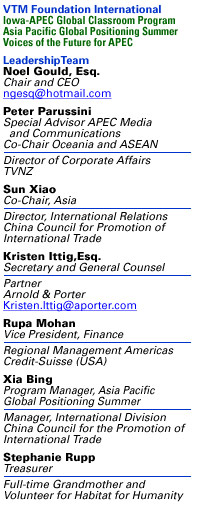Because
of our interactions with global markets, media and technology, we
are all prone to become global citizens regardless of our home address,
family heritage, culture, faith or personal plans for the future.
That is why students and educators – as well as their families
– need great global classrooms to prepare them for the challenges
and opportunities that this expanded citizenship will bring.
My learning and teaching journey has set me on an adventure in global
citizenship that reaches from my Mexican upbringing near the U.S.-Mexico
border, to a study abroad semester in Southern France, to a Masters
in Latin American and Caribbean Studies at NYU. I’ve taught
global studies in Monterrey and led students throughout the Asia
Pacific, including China, Vietnam and Australia. And that
was just last semester!
From all this I know that creating great global classrooms takes
a team effort. Students, educators, business and civic leaders,
as well as wise observers and commentators need to share their questions
and discoveries, while charting both persistent and emerging problem
areas and proven best practices.
This special feature on our website allows me to share some of the
resources my students are working with as we explore global issues.
I hope you will email me your recommendations, so we can all learn
and grow as global citizens.
Elda Cantu
Global Education Director
VTM / Voices
Professor, MTEC Santa Catarina Campus
ecantu@itesm.mx
The
Great Global Classrooms Program is an initiative by the Virtual
Trade Mission Foundation and its partners to link students and educators
from North America and the Asia Pacific in order to share and understand
the different challenges of the global economy in today's youth.
Every year, high school and college classes in China, Iowa, Mexico,
New Zealand and Vietnam reflect on their vision for the future in
a world where the economic landscape is ever changing and challenging.
In
2009, in the aftermath of the latest financial crisis, students
thought about the implications of the global economy in their own
local communities and drew on the current challenges to devise a
strategy for their future. If there was a question on their mind
it probably was: What can we learn today so that what's going on
now will not happen tomorrow? This poses a challenge for educators
in the classroom, as students are more engaged with certain topics
or trends just as they are developing. One great way of keeping
up is via twitter where you can get short updates on the topics
that interest your classroom, swap tips with other like-minded educators
and build a global network of professionals. Some ideas about how
can teachers use Twitter to their advantage are here;
you can also follow my updates (@eldacantu) in Spanish and English.
This
semester we zoomed in the situation of young people in different
parts of the world, with a selection of Current History's series
on youth around the world published between 2006 and 2007 (with
pieces on gangs in South America, China's 80's generation and Russia's
conservative young people), along with a Foreign Policy article
by Mexican journalist León Krauze about Latin America's youth
(you can find a reproduction here).
And just this December, the UNDP released a report on Mercosur's
young population, which can be accessed here.
All
in all, I've found this semester that contextualizing other region's
economic situation with that of their young people helps students
approach and process the information in a different way. They are
able to draw significant comparisons, contrast with their own lives
and reflect on how similar are their peer's struggles and aspirations
across the globe to their own and to devise new ways in which they
can complement each other and collaborate.
Check out the special report on what we are doing by Iowa's
statewide educational television channel:
DMPS
Channel 12 - Global Classroom Project at Central Academy
Global Classroom Project at Central Academy Students at Central
Academy recently collaborated with students in Mexico, Vietnam and
China to discuss world ... (PDF)
Iowa
began as an agriculturally based state in 1846, when it was ...
Apr 19, 2009 ... We hope that Iowa continues to have an impact around
the world. We also hope that as students in a Global Classroom,
we can help make that ...
Iowa
Great Global Classrooms Program, Fall 2009 (PDF 704k)
And
to show you how you move from reading about globalization to living
and learning it, here is an article from the Des Moines
Register on how our Voices program does just that!
Teens
Represent Iowa Abroad
Past
Program Resources
- The
energy sector continues to be of critical importance to emerging
and developed economies alike. Last September, president Michelle
Bachelet of Chile spoke in the United States about the need to
further trade deals in the Western Hemisphere and the significance
of stabilizing the energy markets in the region. You can listen
to her speech at the Council of the Americas HERE:
If you have trouble with the podcast, you can access it through
this LINK.
.
-
In 2003, Goldman Sachs published a now famous economic report
where Brazil, Russia, India and China (the BRIC countries) were
hailed as the next economic powers of the second half of the 21st
century. These economies represent today only a 15% of the economies
of the G-6, but, according to Goldman Sachs’ projections
of economy and population, should they keep their performance,
these economies might as well surpass the G-6. In fact, if these
trends continue, only Japan and the United States would be among
the six largest economies of the world in the year 2050. You can
find the report HERE.
You might be surprised to hear that some commentators talk
about the BRICM countries, as they include also Mexico. My country,
however, was not included in the original Goldman Sachs projection.
It was until after the huge success of their paper, and of the
hype around the BRIC countries, that the international firm published
a list with the N-11, or the “Next 11”, meaning those
economies that could follow the BRIC countries in the next 50
years. Of the N-11, Goldman Sachs considered that only Mexico
and South Korea had real possibilities of becoming as important
as the BRIC. You can read this second report HERE.
As my students review the predictions and compare different sources,
they are more than determined to make sure that Mexico earns its
place in the BRIC group, although other countries like Vietnam
are doing the same!
.
- Knowledge
is power and thanks to newer technology advancements, many parts
of the world have witnessed a democratization of knowledge. If
you are interested in learning about how Information Technologies
can help bring about prosperity and development in a comparative
perspective, visit the International Development Research Centre’s
webpage, where they have put together a set of success stories
of initiatives around the world. Educators can focus on particular
regions (the website presents Africa, Asia and Latin America)
or select a couple of case studies from each region and direct
students in comparing
best practices from around the world.
.
HOME |



